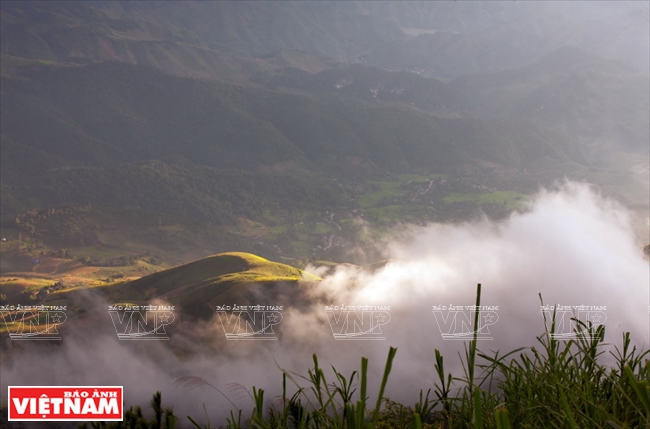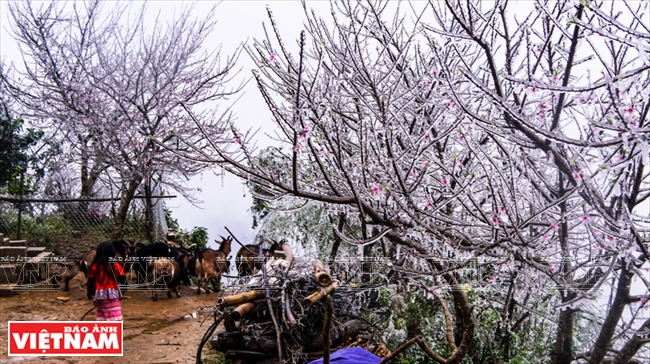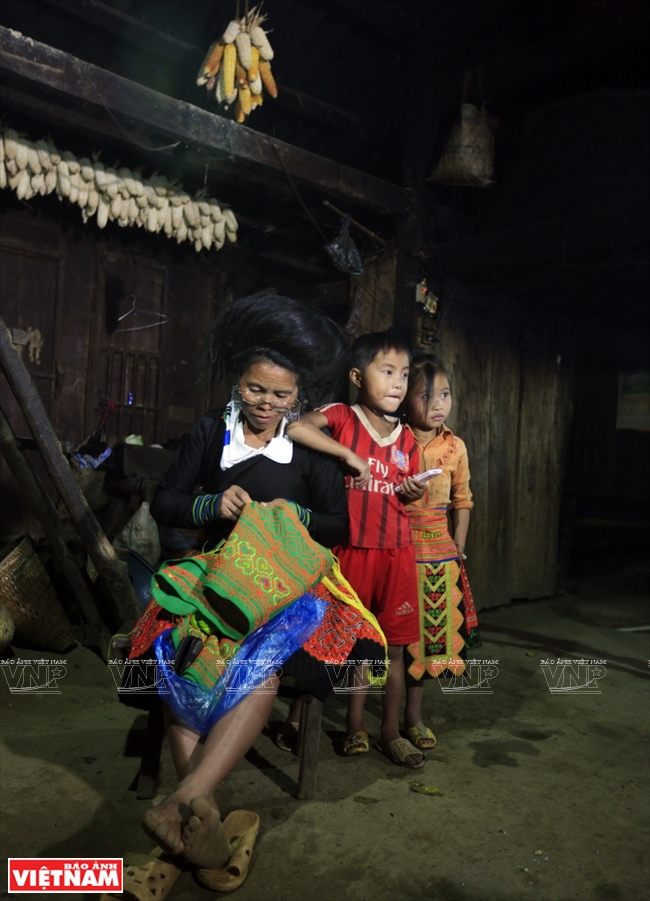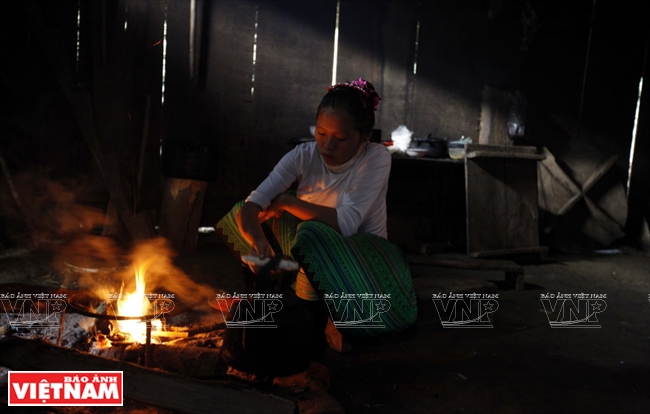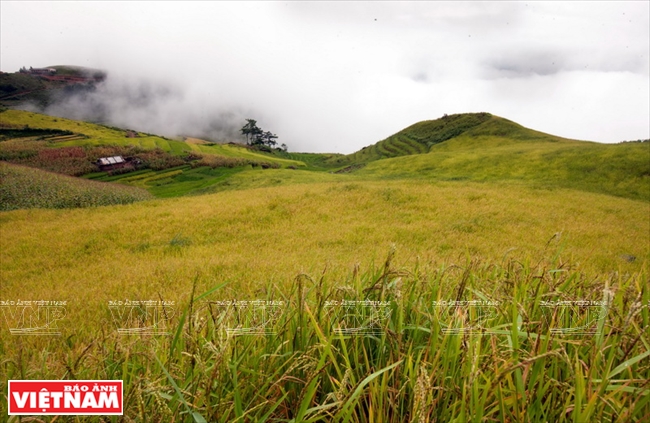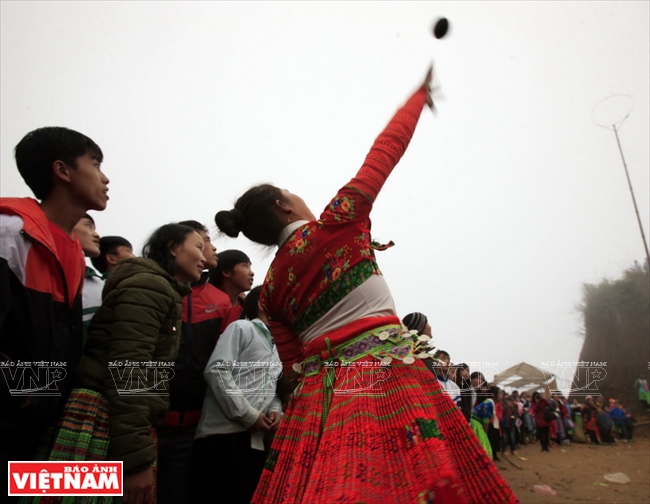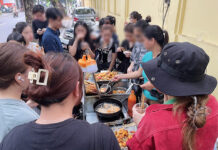“Someone blows khen (pan-pie) at sunset in the forest,
Khen sings the words of love and longing,
Way to the forest, way down the mountain,
There are only stars in the sky,
There are only two lovers on the mountain…”
Arriving at “Song Khung long” (backbone of a dinosaur), the valley of clouds so appealing to mountain adventurers, what stroke me first were the beautiful dresses of Mong women hung to dry in the cloudy air. The sophisticated patterns on those dresses made me think of the ups and downs of Hang Dong, the cloud-covered mountain range in front of me. A local Mong woman told me that clothing would dry despite the clouds in every corner of this region.
|
In early February 2018 when the temperature went down to zero,frost and snow covered forests on the peak of Ta Xua, luring thousands of visitors to this rare natural phenomenon. Photo: Nguyen Van Duy |
|
In early February this year when the temperature went down to zero, frost and snow covered forests on the peak of Ta Xua, luring thousands of visitors to this rare natural phenomenon. I never had such a feeling that the sky and earth were so close as when I saw white clouds from mountain gorges filling in valleys and villages and covering the mountain peaks. Around Ta Xua was only the colour of white smoke, making me get lost amid colourful brocade dresses and beautiful khen notes at the festival. |
Those charming Mong dresses prompted me to visit the Cultural Festival of Ethnic Groups in Bac Yen district, which was held in the centre of Ta Xua commune.
Festival events are very important in the life of the Mong in Bac Yen. A person is not regarded as a Mong if he does not participate in festivals, throw a pao (cloth ball), and play a khen. Schools allow students to have a day off whenever a Mong festival is held. Attending festivals is regarded as an extracurricular activity of schools, according to Mua Thi Ca, a Mong woman who is a staff member of Homestay Tra May, the lodging house in Ta Xua commune where I stayed.
At 8am when clouds still covered Ta Xua, the commune centre where the festival was held was already crowded with people bringing their local specialties for display and sale at the festival. They were the Mong from Bac Yen’s communes, including Hang Chu, Hang Dong, Hong Ngai, Hua Nhan, Lang Cheu, Muong Khoa, Pac Nga, Phieng Ban, Phieng Con, Song Pe, Ta Khoa and Xim Vang. At noon when the clouds grew thicker, more people flocked to the festival, creating a hectic atmosphere with a host of activities, including playing folk games of throwing pao and pushing sticks, and competing in making cakes and brewing liquor. All festival activities took place with the rhythmic sounds of khen in the background.
The Mong are known for their hospitality. Going around the festival area, I was offered liquor by people from Hang Chu, pickled bamboo shoots by those from Xim Vang and grilled fish by locals from Ta Khoa. I was also moved by their kind invitations such as “visit Hang Chu to get drunk with me,” “come to Hong Ngai to try mustard greens as sweet as sugar,” “drop in Xim Vang to have corn liquor and thang co (a specialty dish of the Mong made from horse meat)”.
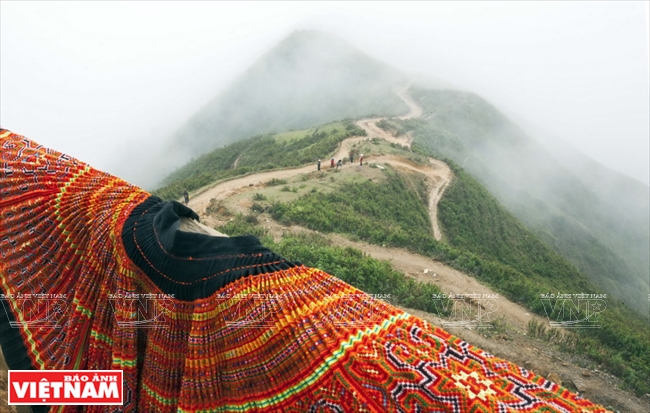 The 1,600 metre-high Backbone of a Dinosaur, one of the three mountains of the Ta Xua range.Photo: Trong Chinh |
| Known as the northern cloudy heaven, Ta Xua, located nearly 2000 metres above sea level, is home to cloudy mountains which create an amazing beauty for this land. The 1,600 metre-high Backbone of a Dinosaur, one of the three mountains of the Ta Xua range, draws many visitors who come to see dawn flickering in the sea of clouds. |
The festival was also a chance for young lovers to date and propose marriage, said Mua A Vu, the manager of Homestay Tra May. At a Mong festival, a man will play a khen and throw pao to the girl he loves, who will catch the pao to show her consent. That’s why, the melodious sounds of a khen are typical of Mong festivals. This is also depicted in “Husband and Wife A Phu”:
“I throw a pao
You do not catch it
You do not love me
The pao drops…”
I googled the word Ta Xua and found 238,000 entries within a second, which, however, are mostly about cloudy areas and snowy villages without much information about the life of the Mong here. This reminded me of the remark by Pham Vu Khanh, a man with knowledge about Ta Xua who is keen on developing tourism here, starting with his Homestay Tra May: “Ta Xua is just as wild as Sa Pa 30 years ago.”
|
“Ta Xua with a population of over 3,000 most of whom are Mong is suitable for community tourism and experience-based tourism as original cultural traits of the Mong are well preserved here, including traditional costumes, housing, habits, practices of belief, and language.”
Le Van Ky
|

